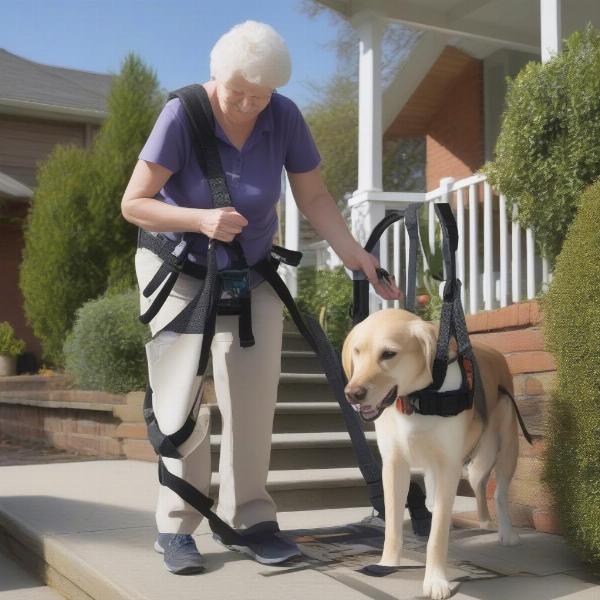Lifting heavy pet dogs can be a necessary task, whether it’s helping them into the car, navigating stairs, or assisting them after an injury. However, improper lifting techniques can lead to injury for both you and your dog. This guide provides practical advice and techniques to lift your heavy dog safely and effectively, ensuring the well-being of both of you.
Understanding Your Dog’s Needs
Before attempting to lift your dog, consider their individual needs and physical condition. Older dogs, dogs with arthritis, or those recovering from surgery require extra care and support. Observe your dog for signs of pain or discomfort, and consult with your veterinarian if you have any concerns. They can advise you on the best way to handle your dog based on their specific health needs.
Preparing for the Lift
A proper warm-up can prevent injuries. Stretch your back and leg muscles before lifting. Ensure the area is clear of obstacles and that you have a secure footing. Communicate clearly with your dog, using a calm and reassuring tone. A help em up harness for dogs can be incredibly useful for larger dogs or those with mobility issues.
The Proper Lifting Technique
When lifting a heavy dog, the key is to support their entire body, distributing the weight evenly. Bend at your knees, not your waist. Place one arm under your dog’s chest, just behind their front legs. Your other arm should support their hindquarters, cradling their abdomen. Lift smoothly and steadily, keeping your back straight and avoiding twisting motions. Hold your dog close to your body to maintain balance and control.
Using Assistive Devices
Various assistive devices can make lifting heavy dogs easier and safer. Slings and harnesses provide extra support, especially for dogs with mobility issues. Ramps can be used for accessing cars or furniture, reducing the need for lifting altogether. A carpet dog hair brush is great for keeping your home clean, but lifting a heavy dog correctly is essential for both your and your pet’s well-being.
 Using assistive devices for lifting dogs
Using assistive devices for lifting dogs
Post-Lift Care
After lifting your dog, gently place them on a stable surface. Monitor their behavior for any signs of discomfort. Reward them with praise and a gentle pet to reinforce positive associations with being lifted. If your dog is recovering from surgery, such as TPLO surgery, special lifting techniques might be necessary. Consult your veterinarian for specific instructions on how to lift a dog after tplo surgery.
Conclusion
Lifting a heavy dog requires proper technique and consideration for their individual needs. By following these guidelines and using assistive devices when necessary, you can lift your heavy pet dogs safely and comfortably, ensuring their well-being and your own. Remember, consulting with your veterinarian is always recommended if you have any concerns about your dog’s mobility or health.
FAQ
- How can I lift my elderly dog with arthritis? Use a sling or harness for extra support and lift slowly and gently.
- What should I do if my dog resists being lifted? Use positive reinforcement and try a different lifting technique or assistive device.
- Is it safe to lift a dog by its legs? No, never lift a dog by its legs. This can cause serious injury.
- How can I teach my dog to cooperate with being lifted? Start with short lifting sessions and reward them with praise and treats.
- What should I do if I hurt my back while lifting my dog? Seek medical attention and consider using assistive devices in the future.
- Where can I find more information on dog lifting techniques? Consult with your veterinarian or a certified professional dog trainer.
- Are there any specific breeds that require special lifting considerations? Yes, breeds with long backs, such as Dachshunds, should be supported along their entire body length.
Expert Insights:
Dr. Emily Carter, DVM: “Always prioritize your dog’s comfort and safety when lifting them. If you’re unsure about the proper technique, consult with your veterinarian for guidance.”
Sarah Miller, Certified Dog Trainer: “Positive reinforcement can go a long way in making lifting a positive experience for your dog. Reward them with treats and praise for their cooperation.”
ILM Dog is your trusted resource for all things dog-related. We offer expert advice on dog breeds, health care, training, nutrition, grooming, and much more. From helping you choose the right trailer hitch steps dogs can use, to finding the perfect does harbor freight allow dogs policy for your next shopping trip, ILM Dog has you covered. For personalized guidance on dog care and access to a wealth of valuable resources, contact us at [email protected] or call +44 20-3965-8624. Visit ILM Dog for all your dog care needs!